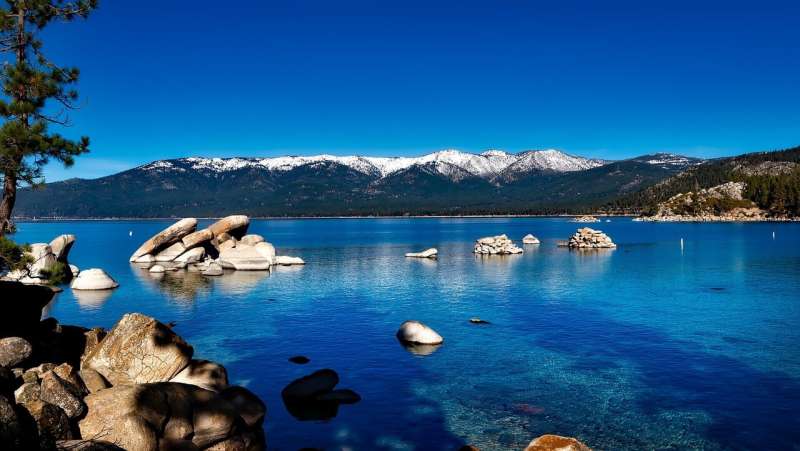Lake Tahoe's clarity improved dramatically over past year

The famed cobalt blue waters of Lake Tahoe became more clear last year, gaining 10 feet in visibility from the year before, according to a new study released Thursday by scientists at the University of California, Davis.
The jump is the largest annual improvement in water clarity at the iconic Sierra Nevada lake since measurements began in 1968.
On average in 2018, a 10-inch white disk lowered from a research boat was visible 70.9 feet under the surface. A year before, it could be seen at just 60.4 feet—the lowest level ever recorded.
The reason for the huge loss of clarity in 2017, scientists said Thursday, was that heavy rains in the winter of 2016-17 washed massive amounts of sand and mud that had built up during the five-year drought into the lake. The big drop-off in the lake's clarity alarmed environmental groups, tourism leaders and many Tahoe lovers.
"A lot of people last year were looking at the decline and saying 'It's not working, Tahoe is not getting better," said Geoffrey Schladow, a professor of engineering at UC Davis and director of the Tahoe Environmental Research Center. "Many of us were saying it was a really extreme year in 2017. It was a massive end to a massive drought. There was a lot of new material coming into the lake, and lots of new erosion. Now the lake has returned to being even better than it was. It's good news."
In 2018, after a relatively mild winter, not as much sediment washed in, returning the lake to a more normal pattern, he said.
Overall, the lake has a long way to go to recover its past ecological health.
In 1968, Tahoe's visibility was 102.4 feet.
After steady development that began in the 1920s and accelerated in the 1950s, Tahoe began to lose its clarity because of erosion from construction, fertilizer from golf courses, loss of wetlands that filter pollutants and other human disruptions.
Over the past 20 years, the state and federal government have spent hundreds of millions of dollars restoring wetlands, tightening building rules and making other changes to try and stop the 1,645-foot deep lake—America's second-deepest, behind Crater Lake—from becoming a muddy green mess of algae and silt.
That work, highlighted around the United States in commonly seen "Keep Tahoe Blue" bumper stickers, has shown slow, but steady progress.
The five-year average of lake visibility—widely considered an indicator of the Lake Tahoe basin's environmental health—is now 70.3 feet, an increase of almost a foot from the previous five-year average.
Thursday's news drew cheers from environmentalists.
"We are thrilled," said Darcie Goodman Collins, CEO of the League to Save Lake Tahoe. "These results encourage us to continue restoring critical habitat and improving our urban areas to keep pollution from entering our lake."
©2019 The Mercury News (San Jose, Calif.)
Distributed by Tribune Content Agency, LLC.



















